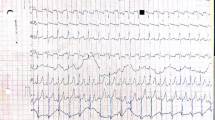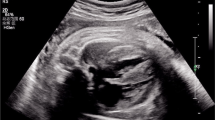Abstract
PRKAG2 encodes the γ2 subunit of AMP-activated protein kinase (AMPK), which is an important regulator of cardiac metabolism. Mutations in PRKAG2 cause a cardiac syndrome comprising ventricular hypertrophy, pre-excitation, and progressive conduction-system disease, which is typically not diagnosed until adolescence or young adulthood. However, significant variability exists in the presentation and outcomes of patients with PRKAG2 mutations, with presentation in infancy being underrecognized. The diagnosis of PRKAG2 can be challenging in infants, and we describe our experience with three patients who were initially suspected to have Pompe disease yet ultimately diagnosed with mutations in PRKAG2. A disease-causing PRKAG2 mutation was identified in each case, with a novel missense mutation described in one patient. We highlight the potential for patients with PRKAG2 mutations to mimic Pompe disease in infancy and the need for confirmatory testing when diagnosing Pompe disease.


Similar content being viewed by others
References
Akman HO et al (2007) Fatal infantile cardiac glycogenosis with phosphorylase kinase deficiency and a mutation in the gamma2-subunit of AMP-activated protein kinase. Pediatr Res 62(4):499–504
Arad M et al (2002) Constitutively active AMP kinase mutations cause glycogen storage disease mimicking hypertrophic cardiomyopathy. J Clin Invest 109(3):357–362
Arad M et al (2003) Transgenic mice overexpressing mutant PRKAG2 define the cause of Wolff-Parkinson-White syndrome in glycogen storage cardiomyopathy. Circulation 107(22):2850–2856
Austin SL et al (2017) Alglucosidase alfa enzyme replacement therapy as a therapeutic approach for a patient presenting with a PRKAG2 mutation. Mol Genet Metab 120(1–2):96–100
Blair E et al (2001) Mutations in the gamma(2) subunit of AMP-activated protein kinase cause familial hypertrophic cardiomyopathy: evidence for the central role of energy compromise in disease pathogenesis. Hum Mol Genet 10(11):1215–1220
Bobele GB et al (1993) Hypertrophic cardiomyopathy during corticotropin therapy for infantile spasms. A clinical and echocardiographic study. Am J Dis Child 147(2):223–225
Burwinkel B et al (2005) Fatal congenital heart glycogenosis caused by a recurrent activating R531Q mutation in the gamma 2-subunit of AMP-activated protein kinase (PRKAG2), not by phosphorylase kinase deficiency. Am J Hum Genet 76(6):1034–1049
Colan SD (2010) Hypertrophic cardiomyopathy in childhood. Heart Fail Clin 6(4):433–444 vii-iii
de Vries JM et al (2012) Effect of enzyme therapy and prognostic factors in 69 adults with Pompe disease: an open-label single-center study. Orphanet J Rare Dis 7:73
Doyle LW, et al (2014) Early (<8 days) postnatal corticosteroids for preventing chronic lung disease in preterm infants. Cochrane Database Syst Rev (5): CD001146
Fu L et al (2016) Identification of LAMP2 mutations in early-onset Danon disease with hypertrophic cardiomyopathy by targeted next-generation sequencing. Am J Cardiol 118(6):888–894
Gollob MH (2008) Modulating phenotypic expression of the PRKAG2 cardiac syndrome. Circulation 117(2):134–135
Gollob MH et al (2001) Identification of a gene responsible for familial Wolff-Parkinson-White syndrome. N Engl J Med 344(24):1823–1831
Gollob MH et al (2002) PRKAG2 cardiac syndrome: familial ventricular pre-excitation, conduction system disease, and cardiac hypertrophy. Curr Opin Cardiol 17(3):229–234
Hamdan MA et al (2010) Antenatal diagnosis of pompe disease by fetal echocardiography: impact on outcome after early initiation of enzyme replacement therapy. J Inherit Metab Dis 33(Suppl 3):S333–S339
Hardie DG (2003) Minireview: the AMP-activated protein kinase cascade: the key sensor of cellular energy status. Endocrinology 144(12):5179–5183
Hay WW Jr (2012) Care of the infant of the diabetic mother. Curr Diab Rep 12(1):4–15
Huie ML et al (1994) Aberrant splicing in adult onset glycogen storage disease type II (GSDII): molecular identification of an IVS1 (−13T-->G) mutation in a majority of patients and a novel IVS10 (+1GT-->CT) mutation. Hum Mol Genet 3(12):2231–2236
Kelly BP et al (2009) Severe hypertrophic cardiomyopathy in an infant with a novel PRKAG2 gene mutation: potential differences between infantile and adult onset presentation. Pediatr Cardiol 30(8):1176–1179
Kemp BE et al (1999) Dealing with energy demand: the AMP-activated protein kinase. Trends Biochem Sci 24(1):22–25
Kim M et al (2014) Mutation in the gamma2-subunit of AMP-activated protein kinase stimulates cardiomyocyte proliferation and hypertrophy independent of glycogen storage. Circ Res 114(6):966–975
Kishnani PS et al (2006) Pompe disease diagnosis and management guideline. Genet Med 8(5):267–288
Kishnani PS et al (2014) Methods of diagnosis of patients with Pompe disease: data from the Pompe registry. Mol Genet Metab 113(1–2):84–91
Laforet P et al (2006) A new mutation in PRKAG2 gene causing hypertrophic cardiomyopathy with conduction system disease and muscular glycogenosis. Neuromuscul Disord 16(3):178–182
MacRae CA et al (1995) Familial hypertrophic cardiomyopathy with Wolff-Parkinson-White syndrome maps to a locus on chromosome 7q3. J Clin Invest 96(3):1216–1220
Murphy RT et al (2005) Adenosine monophosphate-activated protein kinase disease mimicks hypertrophic cardiomyopathy and Wolff-Parkinson-White syndrome: natural history. J Am Coll Cardiol 45(6):922–930
National Center for Biotechnology Information: ClinVar (2017). Retrieved from https://www.ncbi.nlm.nih.gov/clinvar/variation/4027
Roberts AE et al (2013) Noonan syndrome. Lancet 381(9863):333–342
Xu Y, et al (2017) A novel, de novo mutation in PRKAG2 gene: infantile-onset phenotype and signaling pathway involved. Am J Physiol Heart Circ Physiol: ajpheart 00813 02016
Author information
Authors and Affiliations
Corresponding author
Ethics declarations
Conflict of interest
R. D. Torok, S. Austin, C. Phornphutkul, K. Rotondo, D. Bali, G. Tatum, S. Wechsler, A. Buckley, and P. Kishnani declare that they have no conflict of interest.
Additional information
Responsible Editor: Olaf Bodamer, MD PhD
Rights and permissions
About this article
Cite this article
Torok, R.D., Austin, S.L., Phornphutkul, C. et al. PRKAG2 mutations presenting in infancy. J Inherit Metab Dis 40, 823–830 (2017). https://doi.org/10.1007/s10545-017-0072-0
Received:
Revised:
Accepted:
Published:
Issue Date:
DOI: https://doi.org/10.1007/s10545-017-0072-0




